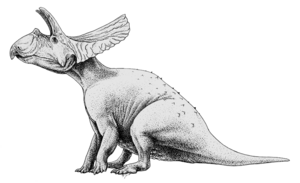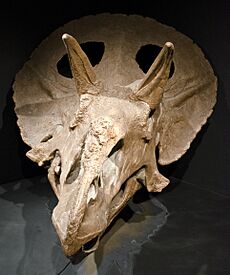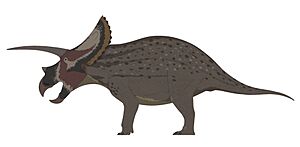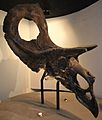Torosaurus facts for kids
Quick facts for kids TorosaurusTemporal range: Upper Cretaceous
|
|
|---|---|
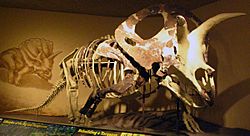 |
|
| Mounted Torosaurus in Milwaukee | |
| Scientific classification | |
| Kingdom: | |
| Class: | |
| Superorder: | |
| Order: | |
| Suborder: | |
| Infraorder: | |
| Family: | |
| Subfamily: |
Ceratopsinae
|
| Genus: |
Torosaurus
Marsh, 1891
|
Torosaurus (meaning "pierced lizard") was a large, quadrupedal, plant-eating Ceratopsian dinosaur with three horns on its large head. Torosaurus hatched from eggs and may have lived in herds.
Torosaurus lived during the Upper Cretaceous, about 70–65 million years ago, in what is now western North America. It was similar to Triceratops. Some had thought that Triceratops was a younger form of Torosaurus.
Torosaurus possessed the largest skulls of any known land animal, with the frilled skull reaching 2.77 metres (9.1 ft) in length. Torosaurus is thought to have been the same size as the contemporary Triceratops, but is distinguished by an elongated frill with large oval shaped openings, long squamosal bones of the frill with a trough on their upper surface, and the presence of five or more pairs of hornlets on the back of the frill. Torosaurus also lacked the long nose horn seen in Triceratops prorsus. It instead resembled the earlier and more basal Triceratops horridus, thanks to having a short nose horn. Three species have been named so far: Torosaurus latus, T. gladius, and T. utahensis. T. gladius is no longer considered a valid species, however.
Discovery and species
In 1891, two years after the naming of Triceratops, a pair of ceratopsian skulls with elongated frills bearing holes were found by John Bell Hatcher in Niobrara County in southeastern Wyoming. Hatcher's employer, paleontologist Professor Othniel Charles Marsh, coined the genus Torosaurus for them.
The name Torosaurus is frequently translated as "bull lizard" from the Latin noun taurus or the Spanish word toro, but is much more likely derived from the Greek verb τορέω (toreo), which means "to perforate". The allusion is to the fenestrae, "window-like" holes, in the elongated frill, which have traditionally served to distinguish it from the solid frill of Triceratops. Much of the confusion over etymology of the name results from the fact that Marsh never explicitly explained it in his papers.
Two Torosaurus species have been identified:
- T. latus Marsh, 1891 (type species). Latus means "the wide one" in Latin, in reference to the frill.
- T. utahensis (Gilmore, 1946) Lawson, 1976
Another species was subsequently regarded as identical to T. latus:
- T. gladius Marsh, 1891. Gladius is "sword" in Latin, in reference to the elongated shape of the squamosal.
T. latus was based on holotype YPM 1830, which is a partial skull. The holotype of T. gladius was specimen YPM 1831, which is an even larger skull. Both fossils were found in the Lance Formation of the late Maastrichtian. Similar specimens found in Wyoming, Montana, South Dakota, North Dakota, Colorado, Utah, and Saskatchewan have since been referred to Torosaurus. Those that can be identified with some certainty include ANSP 15192 (a smaller individual in South Dakota uncovered by Edwin Harris Colbert in 1944), MPM VP6841 (a partial skeleton with a skull mounted at the Milwaukee Public Museum), SMM P97.6.1 (a skull lacking the snout), and two partial skulls from the Hell Creek Formation reported in 2002: MOR 981 (discovered in 1998) and MOR 1122 (from 2001). Fragmentary remains that could possibly be identified as Torosaurus have been found in the Big Bend Region of Texas and the San Juan Basin of New Mexico. Paleontologists have observed that Torosaurus specimens are uncommon in the fossil record, with specimens of Triceratops being much more abundant.
Torosaurus utahensis was originally described as Arrhinoceratops utahensis by Charles Whitney Gilmore in 1946, based on specimen USNM 15583 (a frill fragment from Emery County, Utah). In 1976, it was renamed to Torosaurus utahensis by Douglas Lawson. Review by Robert Sullivan et al. in 2005 left it as Torosaurus utahensis and somewhat older than T. latus. In 2008, Rebecca Hunt referred considerable additional material to this species. Research has not yet been published on whether T. utahensis should be regarded as a new genus or, as has been suggested for T. latus, the mature growth stage of a species of Triceratops.
Description
The individuals referred to Torosaurus are all large, comparable to the largest Triceratops specimens, measuring 7.5 to 9 m (25 to 30 ft) long and weighing 4 to 6 t (8,800 to 13,200 lb). Due to the elongated frill, the skull length is especially considerable. Hatcher estimated the skull of YPM 1830 at 2.2 m (7.2 ft) and that of YPM 1831 at 2.35 m (7.7 ft). In 1933, Richard Swann Lull increased this to 2.4 m (7.9 ft) and 2.57 m (8.4 ft), respectively. Based on this, Torosaurus was seen as having the longest skull of any known land animal. In 1998, however, Thomas Lehman claimed that a Pentaceratops specimen possessed a partial skull that would have been 2.9 m (9.5 ft) long in life. This was again doubted by Nicholas Longrich who, in 2011, named this exemplar as a separate genus, Titanoceratops, and concluded its skull had been reconstructed as too long. Furthermore, in 2006, Andrew Farke had pointed out that the new skulls described by him were even longer on average than Hatcher's original two. MOR 1122 has a length of 2.52 m (8.3 ft) and MOR 981 has a length of 2.77 m (9.1 ft). The well preserved skull of the Torosaurus specimen nicknamed "Adam", first put on display in 2023, is the largest known at 3 m (9.8 ft) long.
In 2006, Farke established some diagnostic traits of Torosaurus. The frill is extremely long in comparison to the remainder of the skull. The rear edge of the frill bears ten or more epiperietals, or triangular osteoderms. A midline triangular osteoderm is absent. Likewise, no osteoderm straddles the parietal-squamosal boundary. The parietal bone is thin and pierced by parietal fenestrae in the form of circular or transversely ovalur openings. The parietal bone is about 20% wider than it is long. Farke identified a single trait in which T. latus differed from both Triceratops horridus and T. utahensis. Its squamosal bore a conspicuous ridge on the edge with the parietal combined with a deep longitudinal trough parallel to it.

Farke pointed out that the known Torosaurus specimens are rather variable. The orbital "brow" horns are sometimes large and curved to the front, as with MOR 981, or sometimes short and straight, as shown by MOR 1122 and ANSP 15191. Also, the position of these horns differs, as they are often located directly on top of the eye socket. With YPM 1831, however, they originate at the rear edge of the orbit. Likewise, there is a variation in the form of the nose horn. YPM 1831 and, to a lesser extent, YPM 1830 have a straight, upright nasal horn, but MOR 981, ANSP 15192, and especially MOR 1122 possess a low bump at most. The frill differs too, as ANSP 15192 and YPM 1830 have a shield curving upwards at the rear, but the frill of YPM 1831 is nearly flat, though this could be an artefact of restoration. The frill of YPM 1831 is also heart-shaped, with a clear midline notch, whereas the rear edge of the other specimens is straight. The frill proportions are quite variable. With YPM 1831, the length-width ratio is 1.26, but MOR 981 has a shield 2.28 times longer than it is wide. The number of triangular osteoderms is difficult to assess, as most fossils seem to have lost them. MOR 981 and MOR 1122 have ten and twelve epiparietals, respectively. YPM 1831 has been restored with a fontanelle in the skull roof, which is possibly authentic. Farke also concluded that the degree of variability did not exceed that shown by related genera.
Farke stressed that, apart from the frill, no systematic differences could be found between Torosaurus and Triceratops. All Torosaurus specimens are similar in that they lack a truly long nasal horn and a horizontal arterial groove at the front base of said horn, but Triceratops fossils with the same combination of traits are not uncommon. In 2008, Hunt concluded that T. utahensis, contrary to T. latus, but similar to Triceratops, possessed a midline epiparietal.
Classification
Below is a ceratopsid cladogram based on the phylogenetic analysis conducted by Sampson et al. in 2010:
| Ceratopsidae |
|
|||||||||||||||||||||||||||||||||||||||||||||||||||||||||||||||||||||||||||||||||||||||
In 1891, Marsh placed Torosaurus in the Ceratopsidae family of Ceratopsia (Greek: "horned faces"), a group of herbivorous dinosaurs with parrot-like beaks that thrived in North America and Asia during the Jurassic and Cretaceous Periods.
Torosaurus has, with its long frill, traditionally been classified in Chasmosaurinae. It was seen as a late member of a line descending from Anchiceratops or Arrhinoceratops. It was thus placed in a different branch from Triceratops which, well into the 1980s, was seen as a member of Centrosaurinae because of its short frill. However, in the 1990s, exact cladistic analysis showed that both genera were chasmosaurines. Recent analyses invariably show a close relationship between Torosaurus and Triceratops.
Images for kids
See also
 In Spanish: Torosaurus para niños
In Spanish: Torosaurus para niños



